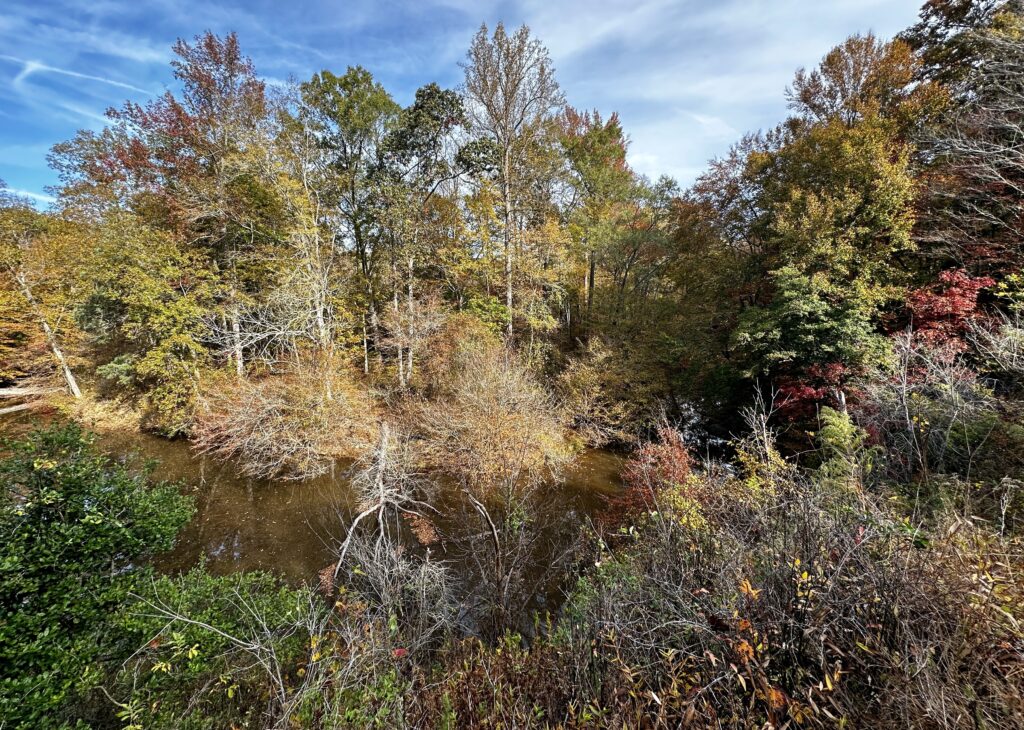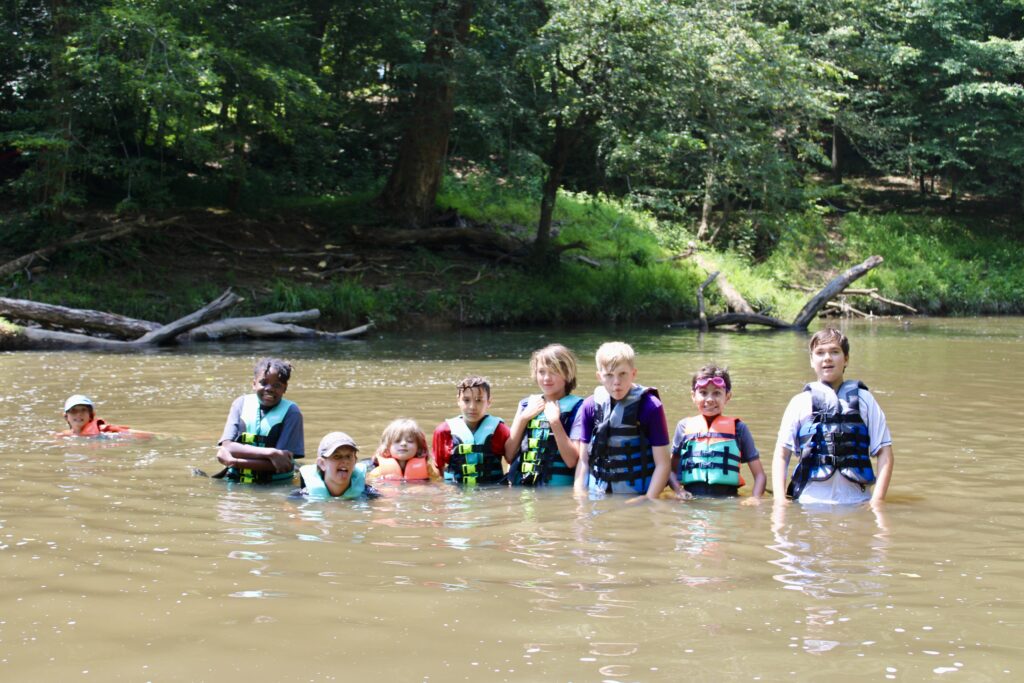
You might remember when we released our Climate Statement back in May. This statement gives a great overview of some of the effects of climate change and how the Eno River Association (ERA) works to mitigate them, but we’ve been itching to dive deeper. This blog post is intended to give a little more clarity to how our work at the ERA contributes to climate resilience within the Eno River watershed. Let’s dive in!
The Eno River Association is deeply invested in and committed to the following:
Increasing carbon sequestration by preserving forested land
The ERA has preserved over 7000 acres of forested land since its establishment in 1966. There are countless benefits of preserving forests, but among the most prominent is carbon sequestration! Carbon sequestration is “the process of capturing and storing atmospheric carbon dioxide”. In a world where carbon dioxide – a prevalent greenhouse gas – is being produced in huge quantities and leading to global warming, the process of sequestration is key. Fortunately, trees are very good at this process, pulling CO2 from the atmosphere during photosynthesis, binding the carbon up in sugar, and releasing oxygen. According to the US Forest Service, “forest growth and afforestation (the establishment of a forest in a previously unforested area) currently offset approximately 16% of U.S. emissions from burning fossil fuels”. This is a hugely important ecosystem service which highlights the need to continue protecting our forested lands.
Reducing flooding impacts and improving water quality by conserving riparian buffers and other lands that naturally absorb, clean, and hold water
Riparian buffer is a term used for a forested area along a river. The forests along the Eno intercept rainfall as it comes down. Then, the soil and organic matter making up the forest floor act as a sponge, absorbing rainfall and slowing its release into the river, while also recharging the groundwater supply. Together, these effects reduce flooding impacts. As water moves through the root systems of trees in a riparian buffer, the roots trap sediments and thus filter the water as it moves to the river. This allows for improved water quality in the river itself. From careful consideration in trail building to advocating for preserving undeveloped lands around the Eno, much of our work involves ensuring that the Eno has adequate riparian buffers. While establishing nature preserves and adding land to Eno River State Park remain a big portion of our work, much of the land we help protect remains in private hands – this is where conservation easements come into play. We work with many landowners in a mutually beneficial process that ensures the natural resources within their land are protected in perpetuity, thus increasing riparian buffers not only on public lands, but also on private lands around the Eno.
Connecting protected lands to ensure species survival, allow for wildlife migration corridors, and reduce habitat fragmentation
Many native species in our area, including river otters, bobcats, and Neuse River waterdogs, rely on large tracts of unbroken forest and healthy rivers for survival. When forested or riparian habitat is fragmented by roads, dams, and residential areas, finding food and mates becomes more of a challenge for these species. Strategic conservation of land in critical areas along the Eno helps to create wildlife migration corridors by connecting protected habitats and thus expanding the potential range of the organisms inhabiting them. Migration corridors become ever more critical as climate change causes species’ distributions to shift and forces animals to find new habitat. If enough protected lands are connected, species are less likely to be trapped in habitat fragments. Instead, they will be able to use these migration corridors to escape areas that are most severely impacted by climate change. ERA is a founding member of the Triangle Connectivity Collaborative that is working to conserve and restore landscape habitat connectivity that ensures long-term protection and resilience of biodiversity and natural resources. Through this collaboration with over 50 various entities, the Eno-New Hope Landscape Conservation Plan, the Eno-New Hope Landscape Conservation Strategic Action Plan, and a conservation model have been developed that “focuses on the critical importance of habitat connectivity for wildlife in the Upper Neuse River basin.”
Providing safe havens for plants and animals by identifying and conserving lands to improve climate resilience
Most wildlife populations are already significantly impacted by human activity. Whether we’re talking about a salamander whose larvae are struggling to survive in a polluted waterway or a bird that has lost most of its habitat to urbanization, many species are struggling to cope with the exploitation of natural resources. Climate change and all the problems that come with it only exacerbate the struggles these animals already face. Meanwhile, freshwater ecosystems account for a huge proportion of the planet’s biodiversity, making them all the more important to protect. When it comes to the Eno, both the river itself and the forests around it provide critical habitat for a plethora of flora and fauna. Without this habitat, native populations would decline and throw Eno ecosystems out of balance. Our land conservation work prioritizes areas that provide habitat for native species and support biodiversity in and around the Eno. In doing so, we strive to increase climate resilience – or the ability of a species or population to cope with the effects of climate change – among native plants and animals.
Educating our community about the importance of freshwater resources
At the ERA, we believe that environmental education and immersive outdoor experiences are powerful tools when it comes to fostering love and passion for our natural resources. We offer a variety of educational opportunities, ranging from public and private programs to summer camps to school visits and field trips, and we cover topics like Indigenous history, macroinvertebrates, and everything in between. The importance of the natural and historical resources of the Eno River Basin is the common thread that connects all of our programs. Whether we are discussing the Eno’s importance as a local drinking water source, an oasis for recreational opportunities, or sacred grounds for local tribal groups, we strive to spark nuanced conversations about our collective reliance on freshwater systems. Our goal is to provide participants with fun, meaningful experiences on the Eno that cater to what it is they love about the outdoors. In the process, we hope they nurture or develop a love for the Eno River that makes them feel empowered to help us protect it in perpetuity.
Advocating against development that will exacerbate climate change in our region
Urban areas in North Carolina are expanding rapidly. These areas tend to have more impervious surfaces – or hard surfaces that do not allow water to penetrate them (think roads, buildings, parking lots) – and fewer trees to provide shade and absorb rainfall. As a result, these areas experience higher temperatures (known as the “heat island effect”) and more flooding. Green spaces are critical climate moderators: because of their role in the carbon and water cycles, forests help to decrease atmospheric temperatures, moderate precipitation, and filter runoff. It is essential that development be carefully regulated to ensure compliance with green standards and avoid destruction of forests and riparian areas. Our most recent advocacy project involved working alongside Horton Hills Homeowners Association and Point Ridge Park to reduce the impervious surfaces and increase the riparian buffers associated with an Eno-adjacent development near West Point on the Eno. We will continue to address any potential threats to the health of the Eno River, its surrounding lands, and the communities that rely on it.
Committing to support the communities and people that are most affected by climate change
The impacts of climate change, such as extreme heat, intense storms, and sea level rise, are felt most intimately by low-income communities and people of color. This is due to a long and complex history of colonization, segregation, and systemic racism, the effects of which are still felt today and which have led to the need for the environmental justice movement. The ERA is committed to environmental justice, the idea that both the benefits provided by the natural environment and the burden of climate change should be spread equitably among social groups. One of the ways in which we are prioritizing environmental justice in our work is through our strategic conservation plan. This community and partner led plan, scheduled to be completed in the spring of 2024, will center environmental justice and climate resilience goals within a prioritized plan for proactive natural, cultural, and historic resource protection across the entire Eno River basin. We recognize that there is a great deal more work to be done, and we will continue to listen and learn along the way.

Additional Reading:


